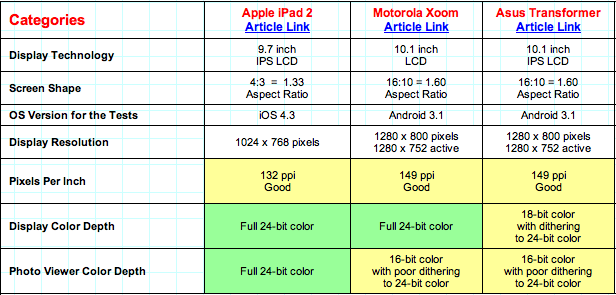Tablet display shootout: iPad 2 trounces the droid tabs

The display is the single most expensive component of a tablet computer, but it's also important because the display is the primary i/o interface and it determines the quality of the visual experience for every app that it runs.
Ray Soneira of DisplayMate Technologies has posted an incredibly in-depth Tablet Display Shoot-Out comparing the displays that ship in the iPad 2, Motorola Xoom and Asus Transformer. His comparison table summarizes the lab measurements he conducted on the trio of tabs in the following categories:
- Screen Reflections
- Brightness and Contrast
- Colors and Intensities
- Viewing Angles
- Display Backlight Power Consumption
- Running Time on Battery
He concludes that the iPad 2 display beats the displays on two Android tablets quite handily:
The iPad 2 was the clear winner in every category. The Asus Transformer was a solid second, and the Motorola Xoom was way below in last place.
The iPad 2 was the clear winner in every category. The Asus Transformer was a solid second and impressive for a $399 Tablet. The Motorola Xoom was significantly below the display quality of the iPad 2 and Asus Transformer. It is a cheap low-end poorly calibrated display, which is shocking for the most expensive $599 Tablet.
In addition to testing the current crop of tablet displays, Soneira also analyzes three of the most popular iPad rumors:
- The next generation Tablets will have OLED Organic LED displays. Right now this can be ruled out based on cost and insufficient production volume, especially in the case of the iPad. OLEDs are improving rapidly, but currently they have lower peak brightness and lower power efficiency than LCDs – both of which are very important for Tablets because of their relatively large screens. So, unlikely for the next generation, but undoubtedly coming in the near future…
- The next generation iPad will quadruple the number of screen pixels with a resolution of 2048x1536. This would undoubtedly be a great marketing move but it’s technically an overkill and comes with a large penalty in cost and performance – requiring significantly more processing power, more memory and battery power, plus lowering the display brightness efficiency. Hopefully display pixels will not follow the same path as the camera Mega Pixel wars – because like them more pixels lowers performance after reaching a certain point. Apple had to double the resolution on the iPhone 3GS because its 480x320 resolution was very low. The iPad is starting with a much higher 1024x768 so Apps hard coded for the iPad 1 and 2 can be rescaled easily by the OS up to the new iPad 3 resolution.
- An iPad Retina Display – to make the iPad 3 a Retina Display does not require the same pixels per inch (ppi) as the iPhone 4 Retina Displaybecause it is typically held much further away from the eye, whose visual sharpness is based on angular rather than linear resolution. The iPad is typically held 15-18 inches away as opposed to the iPhone 4’s 12-15 inches. As a result, to meet the 300 ppi Retina Display specification made by Steve Jobs at WWDC for the iPhone 4, an iPad Retina Display would need only 240 ppi. So an iPad Retina Display could start anywhere above 1862x1397 pixels. That is still a major overkill that carries a significant performance and cost penalty – so it would be primarily a marketing ploy.
Read the full Tablet Display Shoot-Out, it's a great read.
